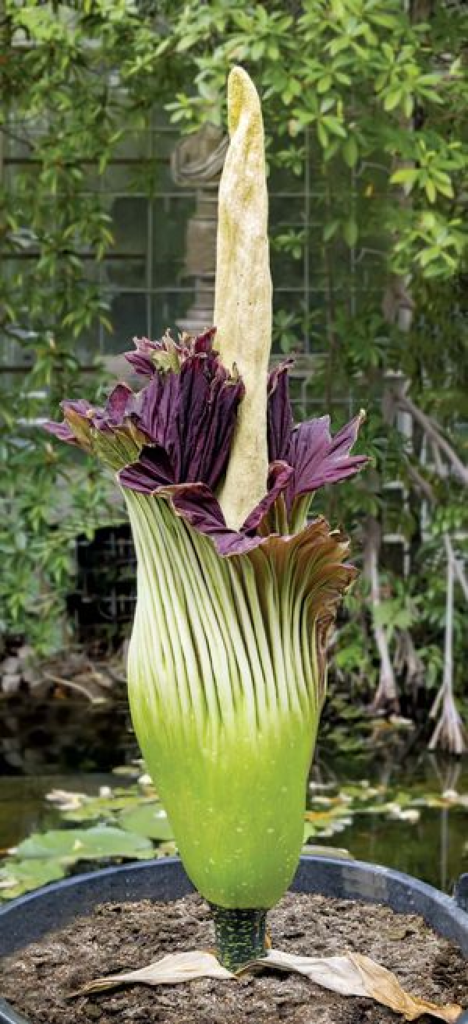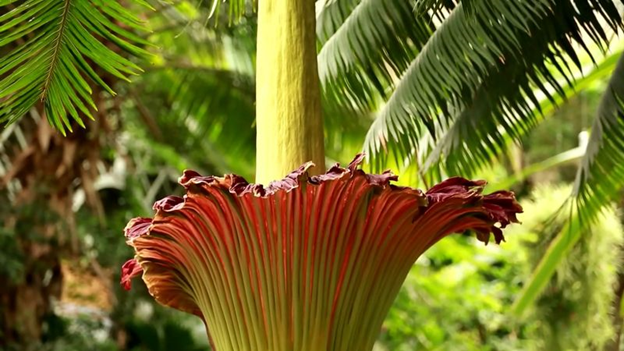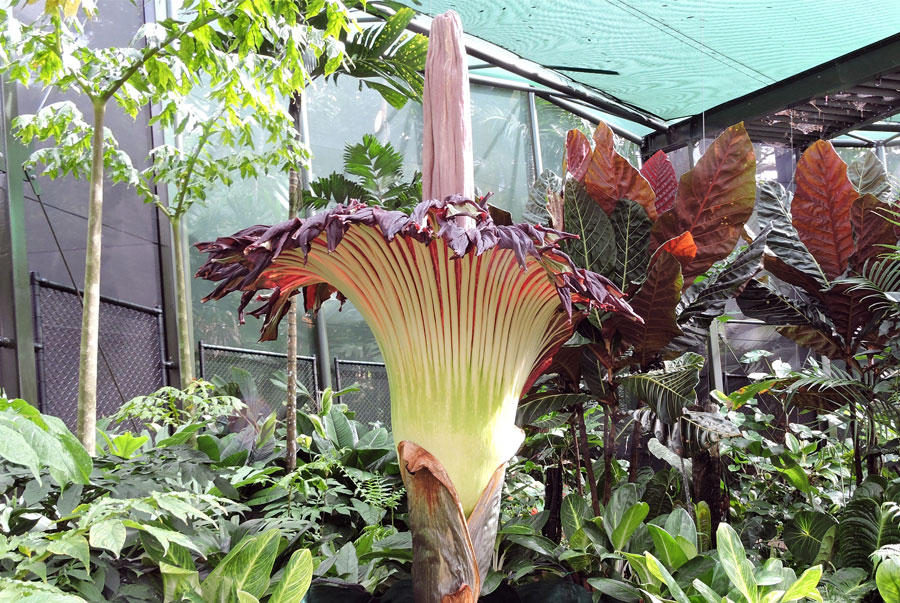Hi readers!
Sorry for the delay as I have not yet fully recovered from my backache.
Dear readers, have you ever heard the name Amorphophallus titanum commonly known as titan arum? It is one of the herbaceous flowering plant of the family Araceae known for its massive foul-smelling inflorescence.
The plant is prevalent in the steep hillsides of rainforests in Western Sumatra, but it is cultivated in Botanic gardens worldwide. It is short-lived, possessing the largest unbranched inflorescence of the plant kingdom that smells like rotting flesh. It take 4-10 years or more between flowerings which becomes a major tourist attraction when in bloom.
Titan arum is one of the most famous species that has remained a mystery until only a few years ago. It may look like a tree but in reality, this is just a single giant leaf called the titan arum (pl, see figure 1).

During the years when the plant does not flower, it usually produces a single, treelike leaf of about 4-7 meters (15-23 feet) tall. The petiole (leaf stalk) is dotted with white patches and features three branches topped with numerous large leaflets.
Most of the food it produces is stored in a massive underground corn which is used to fuel the rapid growth of the inflorescence or a new leaf following a period of dormancy. The corm can weigh up to 70-90 kg and is the largest in the plant kingdom.
After 12-18 months of photosynthesis, the leaf dies, (see figure 2. below) and the plant goes into dormancy. After several such leaf cycles, the plant stored enough energy to flower again.

Figure 2. Dying leaves of titan arum plant
titan arum is a record breaker not because of what is seen in the plant in the above-mentioned picture who’s green stem and leaflets at the top die, rot, and disappear but, beneath the surface of the soil, there is a gigantic tuber, and it is from that tuber the record breaker emerges: The Giant Flower (pl. see figure 3).

Figure 3. The Giant flower of titan arum
When blooming, titan arum exhibited the largest unbranched inflorescence in the plant kingdom as seen in figure 3. The massive inflorescence consists of an inner flower spike, known as a spadix, surrounded by a petal-like collar known as a spathe. The large, furrowed spathe is green to cream color from the outside and tightly encloses the spadix before opening to reveal its deep crimson to purple interior. The upper, visible half of the spadix is smooth and yellowish to brown in color. The entire spadix can reach more than 3 meters (9.8 feet) in height. Although the inflorescence develops over several months, with its growth peaking at a rate of up to 15 cm (6 inches) a day, it only blooms for around 24-48 hours.
This extraordinary event occurs just once every seven years and takes two months to complete but this new growth is neither a trunk nor a leaf but the bud of the biggest flower in the world as it grows into a huge spike the spadix (a type of inflorescence having small flowers borne on a fleshy stem).
The spadix is surrounded by a leaf-like curved bract (known as a spathe) rises from the center of the developing flower and then one evening when darkness spreads over the forest, the giant flower opens as one of the most astonishing of the blooms. These amazing flowers grows in the wild tropical rainforest of Sumatra. But the question is why are they so big?
The function of this big flower is to attract a pollinator. The plant gives off the smell of rotting flesh, but it does something else that can be documented with a high-performance thermographic camera. In 2006 for the first time, heating of the central column (spadix) was documented using a time series analyses of the infrared image sequences which reveals astonishing results. The white areas at the base of the spathe are significantly hotter than the surrounding plant. The spathe keep heating up to the maximum at 37 degrees centigrade: a temperature similar to the body of a mammal.
As it warms up, something else happen inside the flower at the base of the pollen spire where hundreds of small structures begin to produce stringy/fibrous pollen. The titan arum organize and equip itself for the arrival of pollinating insects: tiny sweat bees and probably the carrion beetles as well: both are attracted by combination of the powerful smell and the heat.
Hundreds of unisexual flowers are taken toward the bottom of the spadix within a protective chamber formed by the spathe and mature separately to reduce self-pollination; the dense cream-colored male flowers are located above the pink to orange female flowers. While in bloom, the structure generates heat, more than 90 °F (32 °C) and produces its characteristic carrion odor to attract flesh flies and carrion beetles for pollination. The fertilized flowers develop into bright red to orange spherical fruits (figure 4) and the spathe, and the upper spadix collapse away to facilitate their dispersal, commonly by rhinoceros (Bucares rhinoceros) and other animals. Eventually the remaining structure withers and the plant goes dormant.

Figure 4. Ripening fruits of the titan arum (Amorphophallus titanum).
Isn’t it amazing dear reader? Pl. appreciate the diversity produced by nature. Scientists hasn’t yet fully understood the philosophy behind this type of plant/flower. Kindly follow the link below for more details
https://www.britannica.com/plant/Titan-arum
That’s all for now. See you next week. Take care,
Bye.





